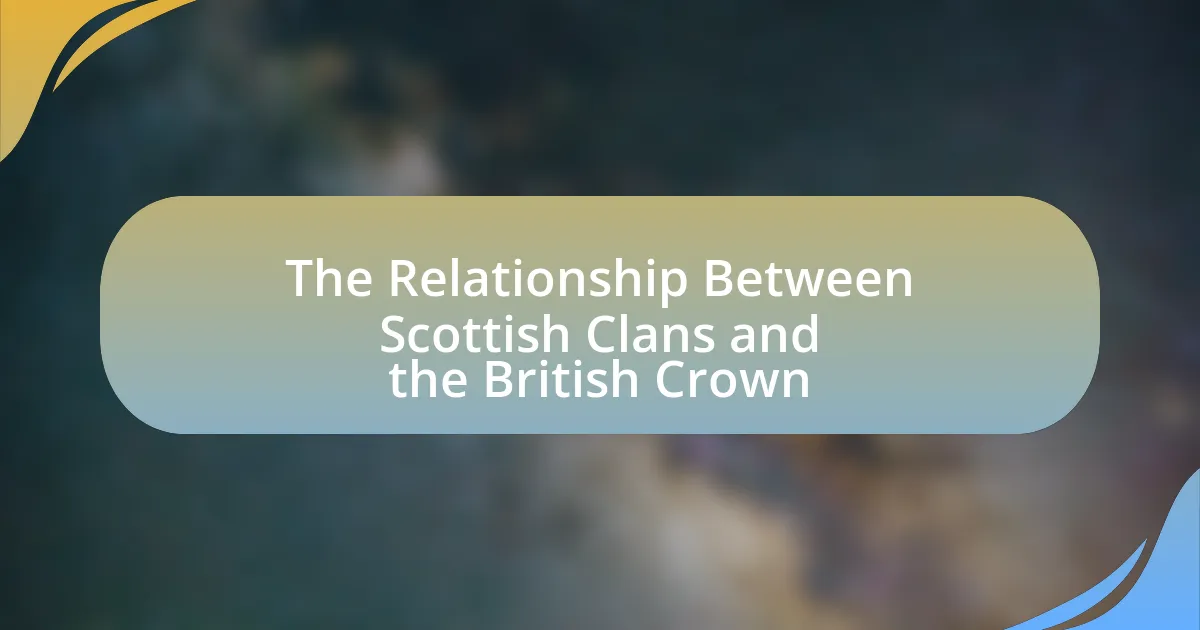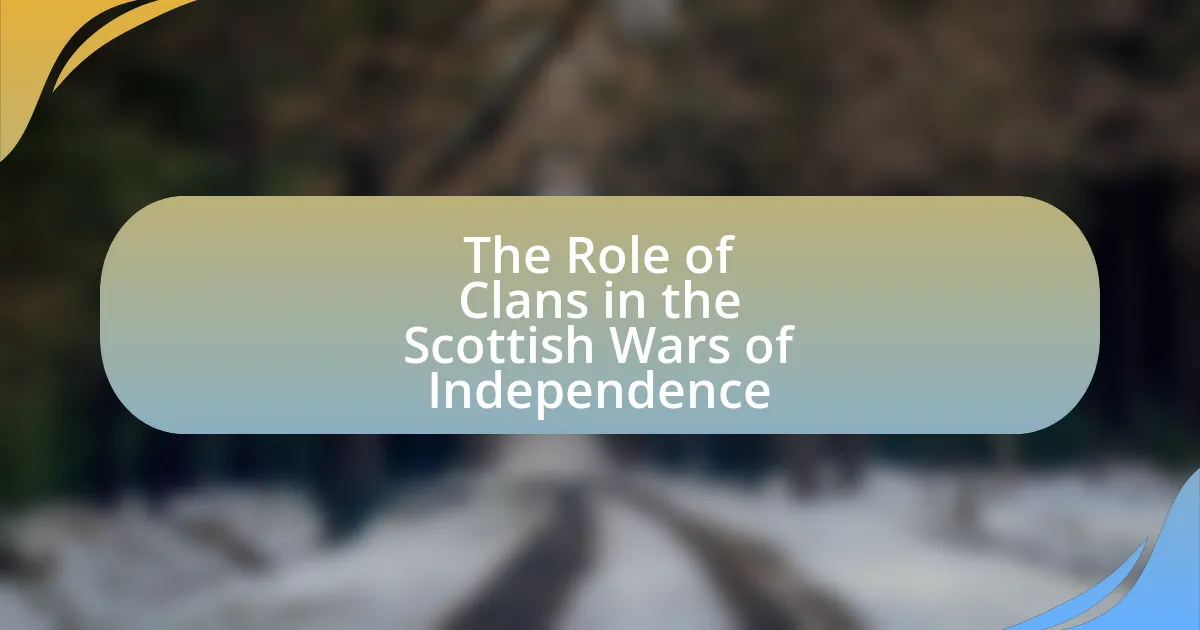The article focuses on the roles and contributions of women in Scottish clans, highlighting their vital involvement in domestic, social, and political spheres. Women managed households, preserved clan traditions, and influenced decision-making, particularly in the absence of male leaders. Their roles varied across clans, shaped by social status and historical events, with notable figures like Lady Margaret Stewart exemplifying women’s significant impact on clan dynamics. The article also discusses how modernization and historical conflicts, such as the Jacobite uprisings, transformed women’s roles, leading to greater recognition and agency within clan societies. Lastly, it addresses the lasting legacies of women in Scottish clans and their contemporary recognition in cultural narratives.

What roles did women play in Scottish clans?
Women in Scottish clans played vital roles in both domestic and social spheres. They were responsible for managing households, raising children, and maintaining clan traditions, which included weaving, cooking, and other essential tasks. Additionally, women often held significant influence in clan decisions, particularly in the absence of male leaders, and could inherit property and titles, as evidenced by historical figures like Lady Margaret Stewart, who wielded power in her clan during the 15th century. Their contributions were crucial for the survival and cohesion of the clan, highlighting their importance beyond traditional gender roles.
How did women’s roles differ across various clans?
Women’s roles varied significantly across Scottish clans, influenced by factors such as clan structure, geography, and cultural practices. In some clans, women held substantial power, managing estates and making decisions during their male relatives’ absences, as seen in the MacDonald clan where women like Mary MacDonald played crucial leadership roles. Conversely, in other clans, women’s roles were more traditional, focusing on domestic responsibilities and child-rearing, as exemplified by the Campbell clan, where women were primarily seen as caretakers. This diversity in roles reflects the broader socio-economic conditions and cultural values of each clan, demonstrating that women’s contributions were not uniform but rather shaped by their specific clan contexts.
What specific responsibilities did women hold within the clan structure?
Women within the clan structure held specific responsibilities such as managing household affairs, nurturing children, and maintaining clan traditions. They played a crucial role in the social and cultural fabric of the clan, often acting as the primary caregivers and educators of the next generation. Additionally, women were involved in agricultural tasks, textile production, and sometimes participated in decision-making processes, particularly in the absence of male leaders. Historical records indicate that women could inherit property and titles, which further solidified their influence within the clan hierarchy.
How did social status influence women’s roles in clans?
Social status significantly influenced women’s roles in clans by determining their access to power, resources, and decision-making. Women of higher social status, such as those from noble families, often held more influential positions within the clan, allowing them to participate in political alliances and manage clan affairs. For instance, noblewomen could negotiate marriages that strengthened clan ties, while lower-status women typically had limited roles focused on domestic responsibilities. Historical records indicate that women like Lady Margaret Stewart wielded considerable influence in clan politics, showcasing how social standing directly impacted their agency and contributions within the clan structure.
What contributions did women make to clan life?
Women made significant contributions to clan life by managing household affairs, preserving cultural traditions, and participating in social and economic activities. They were responsible for the upbringing of children, which ensured the continuation of clan lineage and values. Additionally, women often played crucial roles in the clan’s economy through textile production, agriculture, and trade, thereby supporting the clan’s financial stability. Historical records indicate that women also engaged in decision-making processes, influencing clan leadership and alliances, which were vital for the clan’s survival and prosperity.
How did women contribute to the economy of their clans?
Women contributed to the economy of their clans primarily through agricultural production, textile creation, and managing household resources. In many Scottish clans, women were responsible for cultivating crops, tending livestock, and ensuring food security, which directly supported the clan’s sustenance and economic stability. Additionally, women engaged in weaving and spinning, producing textiles that were essential for clothing and trade, thereby enhancing the clan’s economic output. Historical records indicate that women played a vital role in the domestic economy, often managing the household finances and resources, which were crucial for the clan’s overall economic health.
In what ways did women influence clan politics and leadership?
Women influenced clan politics and leadership primarily through their roles in marriage alliances, inheritance rights, and social influence. Marriage alliances allowed women to forge connections between clans, thereby enhancing political power and stability. For instance, women often served as key negotiators in marriage contracts, which could secure peace or strengthen alliances. Inheritance rights granted women the ability to own and manage land, which was crucial for maintaining clan resources and influence. Historical records indicate that women like Margaret Stewart, who inherited lands and titles, played significant roles in clan leadership. Additionally, women often held informal power through their influence over male relatives, guiding decisions and shaping clan policies. This multifaceted involvement underscores the critical role women played in the political dynamics of Scottish clans.
How did historical events shape women’s roles in Scottish clans?
Historical events significantly shaped women’s roles in Scottish clans by influencing their social status, responsibilities, and contributions to clan dynamics. For instance, during the clan warfare period, women often took on leadership roles in the absence of men, managing estates and making strategic decisions, as evidenced by figures like Lady Margaret Stewart, who led her clan during conflicts in the 16th century. Additionally, the Jacobite uprisings in the 18th century saw women actively participating in support roles, such as providing supplies and shelter to soldiers, which further solidified their importance within clan structures. These historical contexts demonstrate that women’s roles evolved from traditional domestic spheres to more influential positions due to the demands of their times.
What impact did wars and conflicts have on women in clans?
Wars and conflicts significantly impacted women in clans by altering their roles and responsibilities within their communities. During times of war, women often took on additional duties, such as managing households, farms, and clan resources, while men were away fighting. This shift not only increased their authority but also led to greater involvement in decision-making processes. Historical evidence shows that women in Scottish clans, such as the MacDonald and Campbell clans, played crucial roles in supporting military efforts, including organizing supplies and caring for wounded soldiers. Additionally, conflicts sometimes resulted in women becoming heads of households, which further empowered them and changed traditional gender dynamics within the clan structure.
How did the Jacobite uprisings affect women’s status in clans?
The Jacobite uprisings significantly elevated women’s status within Scottish clans by expanding their roles in both political and social spheres. During the uprisings, women took on responsibilities traditionally held by men, such as managing estates and supporting military efforts, which showcased their capabilities and leadership. For instance, women like Flora MacDonald became emblematic figures, actively aiding Jacobite leaders and contributing to the cause, thereby gaining respect and recognition. This shift in roles during the uprisings led to a gradual re-evaluation of women’s contributions in clan society, ultimately enhancing their status and influence in the aftermath of the conflicts.
What roles did women take on during times of conflict?
During times of conflict, women in Scottish clans took on crucial roles such as managing households, supporting military efforts, and participating in direct combat. Women often assumed leadership positions in the absence of men, overseeing clan affairs and ensuring the continuity of clan life. Historical records indicate that women like Flora MacDonald actively aided in military campaigns, while others provided logistical support by gathering supplies and caring for the wounded. Additionally, women were known to defend their homes and communities, exemplified by instances where they engaged in battles alongside male clan members. These contributions highlight the significant impact women had on the resilience and survival of their clans during conflicts.
How did the clan system evolve and affect women?
The clan system in Scotland evolved from a feudal structure into a more complex social organization, significantly impacting women’s roles within these clans. Initially, women held limited power and were often viewed primarily in terms of their relationships to male clan members. However, as clans became more established, women began to assume important roles, particularly in managing clan affairs during times of conflict or absence of male leaders. Historical records indicate that women could inherit land and titles, especially in the absence of male heirs, which allowed them to wield considerable influence within their clans. For instance, figures like the 16th-century clan leader Margaret Campbell of Glenorchy exemplify how women could rise to prominence and actively participate in clan governance. This evolution not only altered the perception of women’s roles but also contributed to a more nuanced understanding of gender dynamics within Scottish society.
What changes occurred in women’s roles during the clan system’s decline?
During the decline of the clan system, women’s roles shifted significantly from being primarily domestic and supportive to more active and independent. As clan structures weakened due to external pressures such as land dispossession and socio-political changes, women began to take on responsibilities that included managing family estates and participating in economic activities. Historical records indicate that women in clans started to engage in trade and agriculture, which were previously dominated by men, thereby gaining a degree of economic autonomy. This transition was further evidenced by the increased visibility of women in leadership roles within their communities, as they often became key figures in maintaining clan identity and cohesion during times of instability.
How did modernization influence women’s contributions in clans?
Modernization significantly enhanced women’s contributions in clans by expanding their roles beyond traditional domestic responsibilities. As societal structures evolved, women began to participate more actively in economic activities, such as agriculture and trade, which were previously dominated by men. This shift was evidenced by the rise of women in leadership positions within clan governance and decision-making processes, particularly during the 19th and 20th centuries when women’s suffrage movements gained momentum. Historical records indicate that women played crucial roles in maintaining clan cohesion and managing resources, thereby solidifying their importance in clan dynamics during periods of modernization.

What are the lasting legacies of women in Scottish clans?
The lasting legacies of women in Scottish clans include their roles as leaders, custodians of culture, and influencers of clan identity. Women often held significant power within their clans, managing estates and making crucial decisions, particularly during times of conflict or absence of male leaders. Historical records, such as those detailing the role of women like Lady Margaret Stewart, illustrate how women could inherit titles and lands, thereby shaping clan dynamics and ensuring continuity of lineage. Additionally, women were instrumental in preserving and transmitting cultural traditions, including music, storytelling, and clan histories, which have contributed to the rich tapestry of Scottish heritage. Their influence is evident in the ongoing recognition of women’s contributions to clan identity and community cohesion, underscoring their vital role in the social fabric of Scottish society.
How are women’s contributions recognized in contemporary Scottish culture?
Women’s contributions in contemporary Scottish culture are recognized through various initiatives, awards, and representation in arts and media. For instance, organizations like Women in Scotland celebrate female achievements across different sectors, highlighting their roles in history, politics, and community development. Additionally, the Scottish Government has implemented policies aimed at promoting gender equality, which include funding for projects that elevate women’s voices and contributions. Events such as the Scottish Women’s Awards further acknowledge and honor the impact of women in various fields, reinforcing their significance in shaping modern Scottish identity and culture.
What role do women play in modern clan societies?
Women in modern clan societies play vital roles that encompass leadership, cultural preservation, and community engagement. In many Scottish clans, women are increasingly recognized as key figures in clan governance, often holding positions such as clan chief or council members, which allows them to influence decision-making processes. Additionally, women contribute significantly to the preservation of clan heritage through organizing events, maintaining traditions, and passing down stories and customs to younger generations. This involvement is supported by the growing acknowledgment of gender equality within clan structures, reflecting broader societal changes. For instance, the Clan Campbell Society has seen women actively participating in leadership roles, demonstrating their essential contributions to clan identity and cohesion.
How are historical narratives of women in clans preserved today?
Historical narratives of women in clans are preserved today through oral traditions, written records, and academic research. Oral histories passed down through generations often highlight the roles and contributions of women in clan life, while written records, such as clan histories and genealogies, document their significance. Additionally, academic research, including studies published in journals like “Scottish Historical Review,” provides a scholarly examination of women’s roles, ensuring that their narratives are recognized and integrated into the broader historical context of Scottish clans.
What lessons can be learned from the roles of women in Scottish clans?
The roles of women in Scottish clans demonstrate the importance of female agency and influence in historical social structures. Women were not merely passive figures; they played crucial roles in clan leadership, decision-making, and the preservation of cultural heritage. For instance, women often managed clan estates and were responsible for the education of children, ensuring the continuation of clan traditions and values. Historical records indicate that women like Lady Margaret Stewart wielded significant power, influencing political alliances and clan dynamics. This highlights that women’s contributions were integral to the clan’s survival and prosperity, teaching modern society about the value of inclusivity and recognizing diverse contributions in leadership and community roles.
How can the contributions of women in clans inspire current gender roles?
The contributions of women in clans can inspire current gender roles by showcasing their historical significance in leadership, decision-making, and community cohesion. Women in Scottish clans often held vital roles, such as managing household affairs, negotiating alliances, and preserving cultural traditions, which demonstrates their influence and capability. For instance, figures like Flora MacDonald, who played a crucial role in the Jacobite cause, exemplify how women’s actions shaped clan dynamics and societal structures. This historical context can encourage contemporary society to recognize and value women’s contributions, promoting a more equitable view of gender roles today.
What best practices can be derived from the historical roles of women in clans?
Best practices derived from the historical roles of women in clans include recognizing their contributions to clan leadership, resource management, and cultural preservation. Women often held significant influence in decision-making processes, as seen in the roles of clan matriarchs who managed family affairs and maintained clan unity. Additionally, women were responsible for the transmission of cultural traditions and knowledge, which underscores the importance of education and mentorship in contemporary settings. Historical evidence shows that women played vital roles in economic activities, such as agriculture and textile production, highlighting the need for inclusive practices that value diverse contributions in community and organizational structures.





